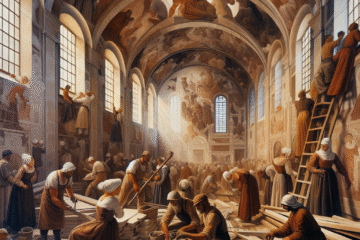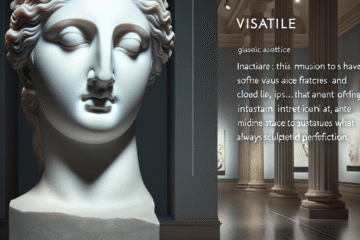I. Introduction
A. Brief Overview of the Significance of Art Collectors in Art History
Art collectors have played an important role in the development of art throughout history. By supporting artists and collecting their works, art collectors have not only helped to preserve artistic creations but have also contributed to the development of art movements and the evolution of artistic styles.
Art collectors have existed since ancient times. The earliest known art collectors were the pharaohs of ancient Egypt, who were known to have collected art and commissioned the construction of temples and monuments decorated with intricate paintings and sculptures. Art collectors also played a key role in the development of classical Greek and Roman art. Wealthy patrons supported the creation of public works and private collections that showcased the skills of their favorite artists.
In the Middle Ages, wealthy nobles and religious institutions commissioned artwork for religious and secular purposes. During the Renaissance, art collectors like Lorenzo de’ Medici in Italy and the Habsburg family in Austria helped to support and promote the work of artists like Leonardo da Vinci, Michelangelo, and Albrecht Dürer.
In the modern era, art collectors have continued to play a vital role in the development of new artistic styles and movements. From the Impressionist paintings of the 19th century to the contemporary art of today, art collectors have been a driving force behind the evolution of art.
B. Purpose of the Article
The purpose of this article is to explore the significance of famous art collectors throughout history and their contributions to art history. By examining the roles that collectors like Lorenzo de’ Medici, Catherine the Great, Peggy Guggenheim, John and Dominique de Menil, and Eli Broad have played in shaping the art world, we can gain a better understanding of how art has evolved over time and the impact that art collectors have had on the artistic community.
In addition, this article will explore the legacy of famous art collections and how they have helped to preserve artistic works and movements. By examining the role of art collectors in shaping art history, we can gain a greater appreciation for the importance of collecting and preserving art for future generations.
II. Historical Overview
A. Discussion of the Earliest Known Art Collectors
Art collectors have existed for thousands of years, and the earliest known examples of art collecting can be traced back to ancient civilizations. In Egypt, the pharaohs collected art and commissioned the construction of temples and tombs adorned with paintings and sculptures. In ancient Greece and Rome, wealthy patrons supported the creation of public works and private collections that showcased the skills of their favorite artists.
B. How the Practice of Art Collection Developed Over Time
As civilizations developed and societies became more complex, the practice of art collecting evolved as well. During the Middle Ages, wealthy nobles and religious institutions commissioned artwork for religious and secular purposes. In the Renaissance, art collectors like Lorenzo de’ Medici in Italy and the Habsburg family in Austria helped to support and promote the work of artists like Leonardo da Vinci, Michelangelo, and Albrecht Dürer.
During the 18th and 19th centuries, the art market expanded as a result of increased trade and international commerce. Wealthy collectors in Europe and America began to travel to other parts of the world and acquire exotic works of art, including Asian ceramics, African masks, and Oceanic carvings. The Industrial Revolution brought new technologies that made the production of art more efficient and affordable, and the rise of museums and public art exhibitions made art more accessible to the general public.
In the 20th century, the art market continued to expand as new art movements emerged and global travel became more widespread. The growth of art fairs and online art sales has made it easier for collectors to acquire works of art from around the world, and the rise of social media has made it easier for artists to connect with collectors and promote their work.
C. The Impact of Art Collectors on the Art Market
Art collectors have had a significant impact on the art market throughout history. By acquiring works of art and supporting artists, collectors have helped to promote new styles and movements and shape the course of art history.
Art collectors have also played a key role in the development of the art market itself. By acquiring and selling works of art, collectors have helped to establish market values and set the standards for what is considered valuable and important in the art world.
In addition, art collectors have been instrumental in the creation and maintenance of public and private art collections. By donating their collections to museums or establishing private foundations, collectors have helped to preserve works of art for future generations and ensure that they remain accessible to the public.
Overall, the impact of art collectors on the art market and art history cannot be overstated. By supporting artists, acquiring and selling works of art, and preserving important collections, art collectors have played a vital role in shaping the course of art history and ensuring that art remains an important and enduring part of human culture.
III. Famous Art Collectors and Their Contributions
Throughout history, art collectors have played a significant role in supporting and promoting the work of artists and shaping the course of art history. In this section, we will explore the contributions of some of the most famous art collectors, including Lorenzo de’ Medici, Catherine the Great, Peggy Guggenheim, John and Dominique de Menil, Eli Broad, and others.
A. Lorenzo de’ Medici and his Patronage of Renaissance Artists
Lorenzo de’ Medici was a prominent Italian statesman and art collector who played a key role in the development of the Renaissance in Italy. He supported and promoted artists like Leonardo da Vinci, Michelangelo, and Botticelli, and his patronage helped to establish Florence as a center of artistic excellence.
Lorenzo’s support for the arts extended beyond his own personal collection, and he was instrumental in the creation of the Medici Palace, which served as a hub for artistic and cultural activity in Florence. His patronage of the arts helped to usher in a new era of artistic expression in Italy and set the stage for the flowering of the Renaissance.
B. Catherine the Great and her Role in Building the Hermitage Museum
Catherine the Great was the Empress of Russia from 1762 to 1796 and a prolific art collector. She acquired works of art from all over Europe and was particularly interested in collecting ancient Greek and Roman art. Her extensive collection of paintings, sculptures, and other works of art formed the basis of the Hermitage Museum, which she established in St. Petersburg in 1764.
The Hermitage Museum is now one of the largest and most important art museums in the world, with a collection that spans more than 3 million works of art. Catherine’s passion for collecting and her commitment to preserving works of art have had a lasting impact on the art world and have helped to ensure that important works of art are accessible to the public.
C. Peggy Guggenheim and her Support for Modern Art
Peggy Guggenheim was an American art collector and patron of the arts who played a key role in promoting modern art in the 20th century. She supported and promoted artists like Jackson Pollock, Mark Rothko, and Salvador Dali, and her collection of modern art was one of the most important of its time.
Guggenheim’s support for modern art extended beyond her own collection, and she was instrumental in the establishment of the Solomon R. Guggenheim Museum in New York City, which she named in honor of her uncle. The museum is now one of the most important art museums in the world and has helped to make modern art accessible to a wider audience.
D. John and Dominique de Menil and their Collection of African and Oceanic Art
John and Dominique de Menil were French art collectors who became interested in African and Oceanic art in the 1940s. They amassed a large and important collection of works from these regions, and their support for these works helped to establish African and Oceanic art as a legitimate and important part of the art world.
The de Menils were also instrumental in the establishment of the Menil Collection in Houston, Texas, which opened in 1987. The collection is now one of the most important private collections of art in the world, with a focus on modern and contemporary art, as well as African and Oceanic art.
E. Eli Broad and his Contributions to Contemporary Art
Eli Broad is an American philanthropist and art collector who has been instrumental in promoting contemporary art in the United States. He has supported and promoted artists like Jeff Koons, Cindy Sherman, and Damien Hirst, and his collection of contemporary art is one of the most important of its time.
Broad’s support for contemporary art extended beyond his own collection, and he was instrumental in the establishment of the Broad Art Foundation in Los Angeles, which supports the creation and exhibition of contemporary art. He was also a major contributor to the creation of the Broad Museum in Los Angeles, which opened in 2015 and features a collection of contemporary art from around the world.
F. Other Notable Art Collectors and Their Impact on Art History
In addition to the collectors mentioned above, there are many other notable art collectors who have made significant contributions to the art world. Some of these collectors include J. Paul Getty, who established the Getty Museum in Los Angeles; Isabella Stewart Gardner, who created a private art museum in Boston; and Alfred Stieglitz, who played a key role in promoting photography as a legitimate art form.
These collectors and others like them have helped to preserve important works of art, promote new artistic styles and movements, and make art more accessible to the public. Their contributions to the art world have had a lasting impact on the course of art history and continue to shape the way we think about and appreciate art today.
IV. Art Collections and their Legacy
Art collections have had a significant impact on the art world throughout history. In this section, we will explore the legacy of famous art collections, including how they have contributed to the preservation of art history and the role of art collectors in shaping art movements.
A. Discussion of the Legacy of Famous Art Collections
Famous art collections have left a lasting legacy that continues to shape the art world today. These collections have been instrumental in preserving important works of art and making them accessible to the public. They have also played a key role in promoting new artistic styles and movements and inspiring future generations of artists.
For example, the Medici collection in Florence, Italy, helped to establish the Renaissance as a major artistic movement, while the Impressionist collection of Paul Durand-Ruel played a key role in promoting Impressionism as a legitimate art form. The collections of Peggy Guggenheim and Eli Broad have also had a significant impact on contemporary art, helping to promote and popularize new styles and movements.
B. How These Collections Have Contributed to the Preservation of Art History
Art collections have been instrumental in preserving important works of art and making them accessible to the public. Many of the world’s most famous art collections are housed in museums, where they can be seen and appreciated by millions of people each year.
In addition to preserving individual works of art, art collections have also helped to preserve entire artistic movements and styles. The collections of the Medici family, for example, helped to preserve the work of Renaissance artists, while the collections of the de Menils helped to establish African and Oceanic art as a legitimate and important part of the art world.
C. The Role of Art Collectors in Shaping Art Movements
Art collectors have played a key role in shaping art movements and promoting new styles and artistic expression. By supporting and promoting artists, collectors have helped to establish new artistic movements and make them accessible to a wider audience.
For example, the art collection of Peggy Guggenheim played a key role in promoting and popularizing the work of Jackson Pollock, Mark Rothko, and other Abstract Expressionist painters in the 1950s. Similarly, the collection of Eli Broad has helped to promote and support the work of contemporary artists like Jeff Koons, Cindy Sherman, and Damien Hirst.
In addition to promoting new artistic movements, art collectors have also been instrumental in challenging established artistic norms and pushing the boundaries of what is considered art. The collections of Marcel Duchamp and Andy Warhol, for example, helped to promote new forms of art like conceptual art and pop art.
Overall, the legacy of art collections and their impact on the art world cannot be overstated. Through their support for artists and their preservation of important works of art, collectors have helped to shape the course of art history and make art accessible to a wider audience. Their contributions to the art world continue to inspire and influence artists and art lovers around the world today.
V. Conclusion
A. Summary of the Article
Art collectors have played a significant role in the development of art throughout history. From the earliest known collectors in ancient Egypt and Greece to modern collectors like Eli Broad, art collectors have supported and promoted artists and shaped the course of art history.
Famous art collectors like Lorenzo de’ Medici, Catherine the Great, Peggy Guggenheim, and John and Dominique de Menil have left a lasting legacy, helping to establish new artistic movements and make art accessible to a wider audience. Their contributions to the art world have had a significant impact on the preservation of art history and the development of new artistic styles and movements.
B. Final Thoughts on the Impact of Art Collectors on Art History
Art collectors have played a vital role in the development of art throughout history. By supporting artists and collecting works of art, collectors have helped to preserve important works of art and make them accessible to the public. They have also played a key role in the promotion and development of new artistic styles and movements.
The impact of art collectors on art history cannot be overstated. Their collections have left a lasting legacy that continues to shape the art world today. By preserving important works of art and promoting new artistic styles and movements, art collectors have helped to ensure that art remains an important and enduring part of human culture.
C. Future of Art Collecting and Its Potential Influence on Art History
The future of art collecting is uncertain, but there is no doubt that collectors will continue to play an important role in the development of art in the years to come. With the growth of new technologies and the rise of global trade, it is easier than ever for collectors to acquire works of art from around the world and support artists from a variety of cultural backgrounds.
As art collectors continue to collect and preserve important works of art, they will undoubtedly play a role in shaping the course of art history in the years to come. Their contributions to the art world will continue to inspire and influence artists and art lovers for generations to come. The future of art collecting is bright, and its potential influence on art history is immense.


